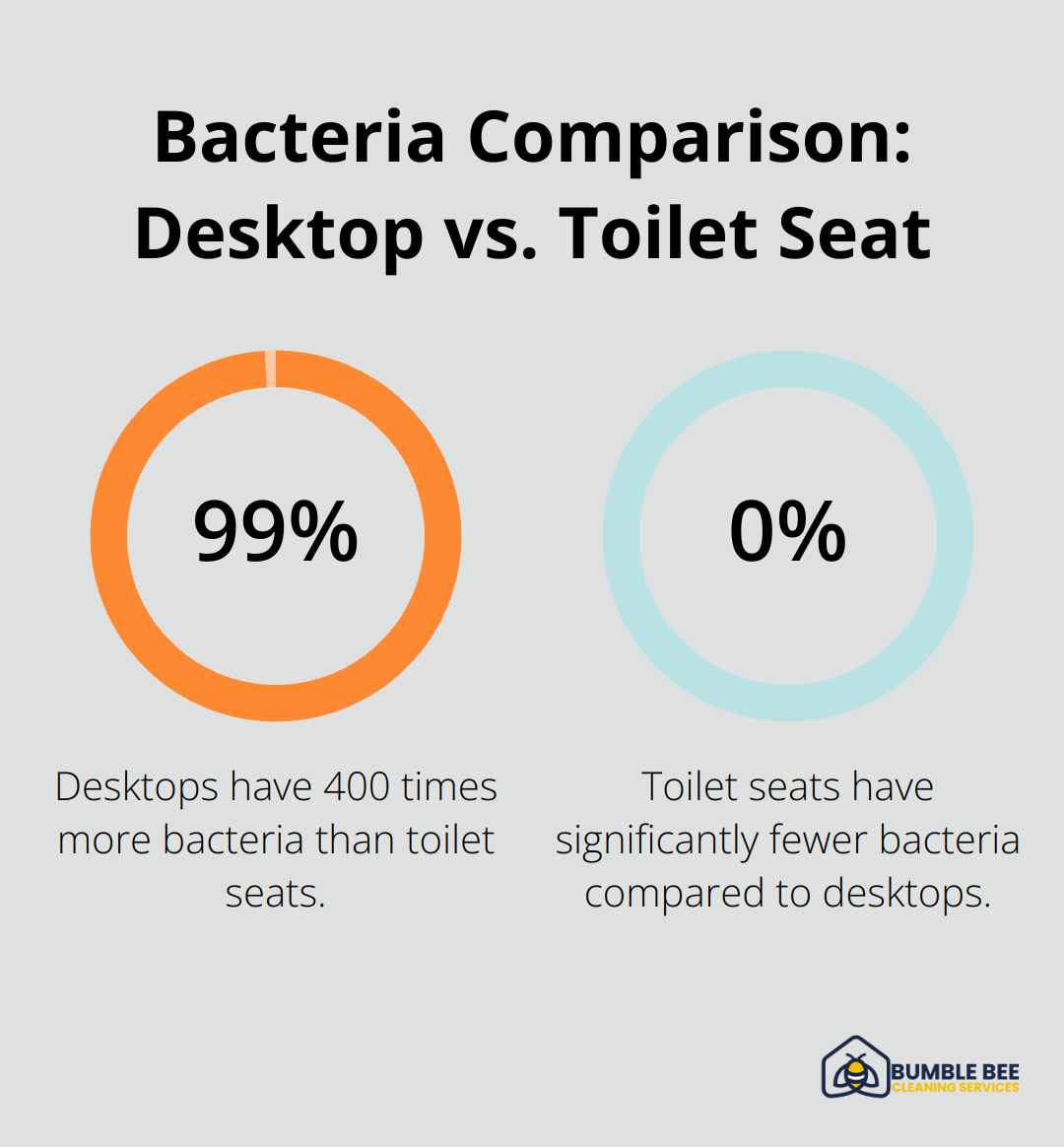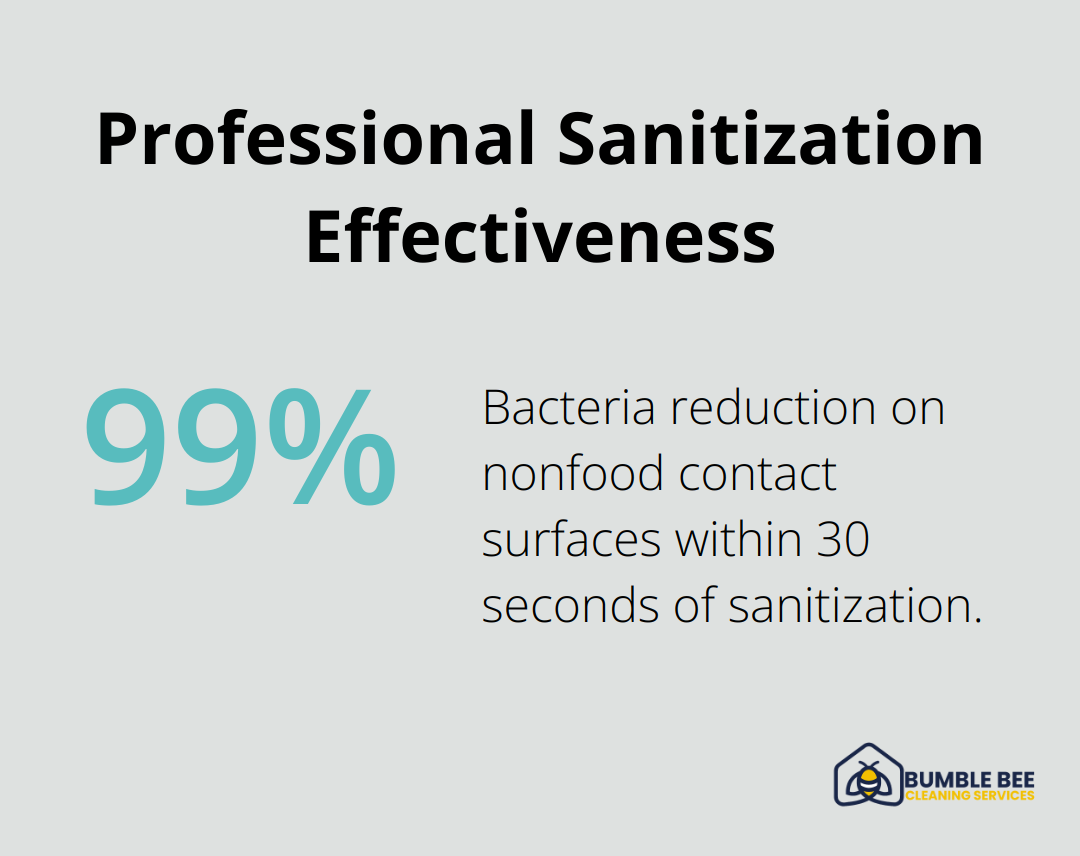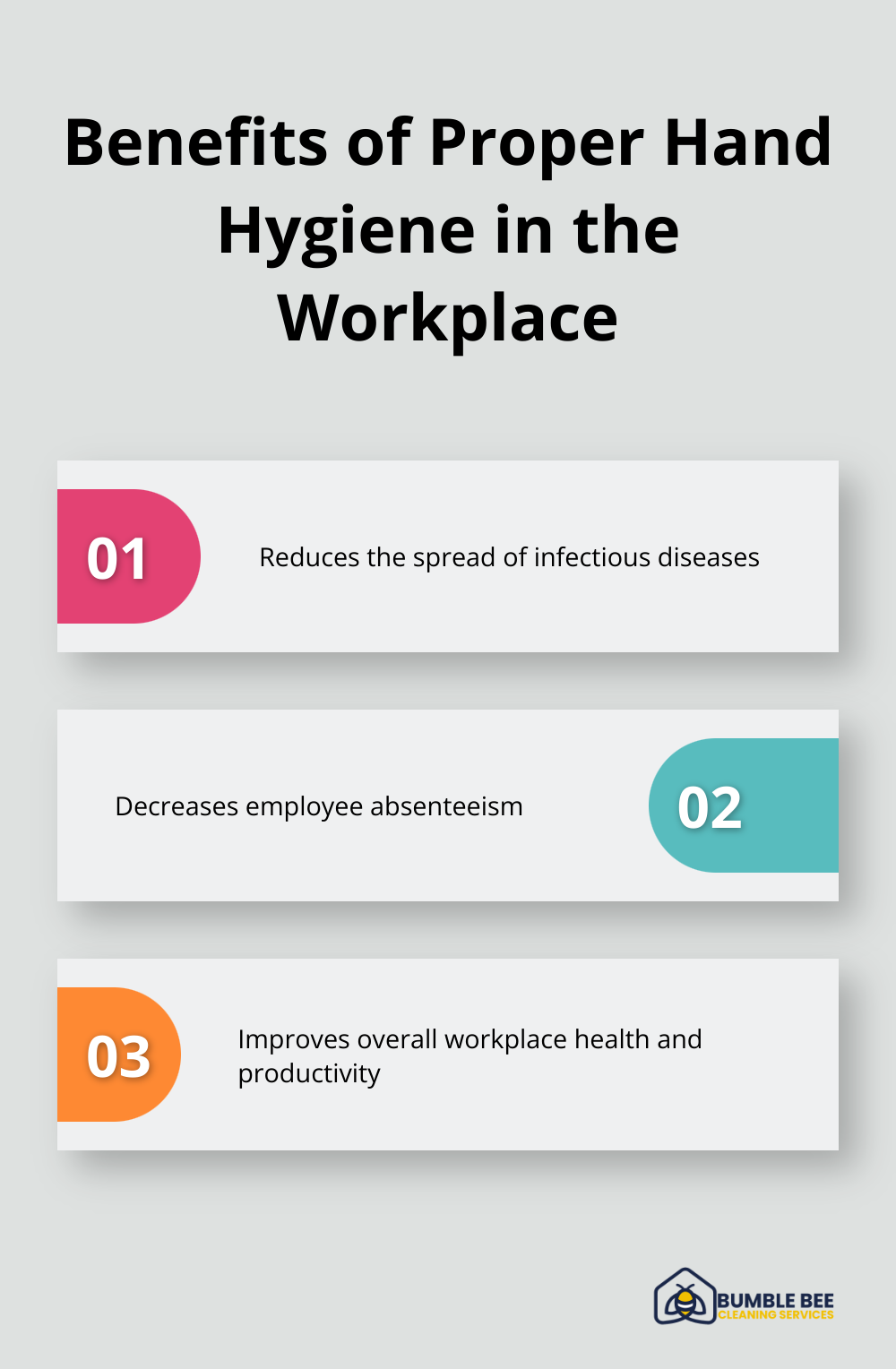Seattle offices may seem clean, but hidden dangers lurk on surfaces and in the air. Bacteria and viruses thrive in shared spaces, posing significant health risks to employees.
At Bumble Bee Cleaning Services, we understand the critical role of commercial sanitization in maintaining a safe work environment. Regular professional sanitization not only protects your staff’s health but also boosts productivity and reduces absenteeism.
What Lurks in Your Seattle Office?
Invisible Invaders: Microbes in the Workplace
Seattle’s bustling office spaces may appear clean at first glance, but they often harbor unseen threats to employee health. Research shows that the average desktop has 400 times more bacteria than the average toilet seat. This startling statistic underscores the importance of thorough sanitization in office environments.

Common pathogens found in offices include influenza viruses, norovirus, and E. coli. These microorganisms can survive on surfaces for hours or even days. The Centers for Disease Control and Prevention (CDC) states that influenza viruses can persist on hard surfaces for up to 48 hours, creating a prolonged risk of infection.
High-touch surfaces pose particular problems. Keyboards, mice, and phones can accumulate more than 20,000 germs per square inch. Door handles, elevator buttons, and shared kitchen appliances also serve as hotspots for pathogen transmission. Research indicates that behaviors in the workplace contribute to the spread of human viruses via direct contact between hands, contaminated surfaces, and the mouth.
Health Consequences of Poor Office Hygiene
The health risks associated with inadequate office sanitization are significant. The Occupational Safety and Health Administration (OSHA) reports that workplace illnesses cost U.S. employers more than $225 billion annually in lost productivity. Common ailments resulting from poor office hygiene include:
- Respiratory infections
- Gastrointestinal illnesses
- Skin infections
These health issues not only affect individual employees but can also lead to widespread absenteeism and decreased overall productivity. The Journal of Occupational and Environmental Medicine found that presenteeism (when employees come to work ill) can cut individual productivity by one-third or more.
Proactive Measures for a Healthier Workspace
To combat these hidden dangers, offices need to implement rigorous sanitization protocols. The Environmental Protection Agency (EPA) recommends using EPA-registered disinfectants effective against a broad spectrum of pathogens. Regular cleaning of high-touch surfaces, ideally multiple times per day, proves crucial.
Advanced sanitization techniques and EPA-approved products ensure thorough disinfection of office spaces. Professional cleaning teams pay special attention to frequently overlooked areas, helping to create a truly clean and safe work environment.
The Role of Professional Sanitization Services
While regular cleaning helps, professional sanitization services offer a more comprehensive approach to office hygiene. These services use industrial-grade equipment and specialized techniques to target and eliminate pathogens effectively.
Professional cleaners understand the nuances of different office environments and can tailor their approach accordingly. They also stay updated on the latest sanitization methods and products, ensuring that your office receives the most effective treatment possible.
As we move forward, it’s clear that maintaining a safe and healthy office environment requires more than just surface-level cleaning. The next section will explore the difference between cleaning and sanitizing, and why professional commercial sanitization services are essential for your Seattle office.
Why Professional Sanitization Matters
The Science of Sanitization
Professional commercial sanitization transcends traditional cleaning methods. It’s a specialized process that targets harmful microorganisms, creating a safer and healthier work environment. The sanitization standard for nonfood contact surfaces is accepted as a reduction of 99.9% (3 logs) within 30 seconds.

Professional sanitization services employ advanced techniques to eliminate pathogens. Electrostatic spraying uses positively charged particles to ensure disinfectants adhere to surfaces, providing more thorough coverage. This method proves particularly effective in hard-to-reach areas.
UV-C light technology stands as another powerful tool in the sanitization arsenal. The Centers for Disease Control and Prevention (CDC) recognizes UV-C as an effective no-touch method for decontamination of surfaces and equipment. However, it’s important to note that protected surfaces should be disinfected after UV-C treatment, and coverings should be changed when visibly soiled or damaged and routinely.
Tailored Approaches for Maximum Effectiveness
Every office space is unique, and professional sanitization services take this into account. They conduct thorough assessments to identify high-risk areas and develop customized sanitization plans. This targeted approach ensures efficient resource use and addresses all potential hotspots for pathogen growth.
In open-plan offices (where shared spaces are common), sanitization efforts focus on high-touch surfaces like communal desks, conference room equipment, and break room appliances. Private offices might require more attention to individual workstations and personal items.
Long-Term Benefits of Regular Sanitization
A regular professional sanitization schedule yields significant benefits. A study published in the American Journal of Infection Control found that proper sanitization can reduce absenteeism due to illness by up to 46%. This translates to substantial cost savings for businesses.
Moreover, a sanitized office environment contributes to improved air quality. The EPA reports that indoor air can be two to five times more polluted than outdoor air (highlighting the importance of thorough sanitization in maintaining healthy indoor environments).
Compliance and Peace of Mind
Professional sanitization services help businesses comply with health and safety regulations. OSHA guidelines emphasize the importance of maintaining clean and sanitary workplaces, and professional services ensure consistent adherence to these standards.
Offices that implement regular professional sanitization often experience a noticeable decrease in employee sick days and an increase in overall productivity. A more positive work atmosphere and increased peace of mind among employees typically result from these efforts.
Choosing the Right Sanitization Partner
When selecting a professional sanitization service, businesses should consider factors such as experience, certifications, and the use of eco-friendly products. Companies like Bumble Bee Cleaning Services (certified by ARCSI, IICRC & OMWBE) offer comprehensive solutions tailored to specific office needs.
The next section will explore practical strategies for implementing an effective sanitization plan in your Seattle office, ensuring a safe and productive work environment for all employees.
How to Create a Robust Sanitization Plan for Your Seattle Office
Develop a Tailored Sanitization Schedule
A comprehensive sanitization strategy for your Seattle office must address specific needs. High-traffic areas and frequently touched surfaces require more attention. The CDC recommends cleaning high-touch surfaces at least daily, with increased frequency for heavily used spaces.
Reception areas, conference rooms, and shared workstations might need sanitization multiple times a day. Less frequented areas (such as storage rooms) can have a less rigorous schedule. The goal is to create a plan that covers all areas without overextending resources.
Many Seattle businesses succeed with a tiered approach:
- Tier 1: Daily sanitization of high-touch surfaces
- Tier 2: Weekly deep cleaning of all areas
- Tier 3: Monthly intensive sanitization (including hard-to-reach areas and air ducts)
Empower Employees Through Hygiene Education
Employee participation plays a vital role in maintaining a sanitized office environment. Hand hygiene can significantly reduce the risk of infectious disease transmission in the home and community.

Implement a comprehensive hygiene education program that covers proper handwashing techniques, correct use of hand sanitizers, and protocols for maintaining personal workspaces. Monthly hygiene workshops led by health professionals can reinforce these practices.
Promote a culture of cleanliness by placing hygiene reminders strategically around the office. The World Health Organization offers free, printable posters on hand hygiene for display in restrooms and common areas.
Select Effective Sanitization Products and Equipment
The choice of sanitization products and equipment is critical for a healthy office environment. The EPA maintains a list of disinfectants effective against various pathogens (including the SARS-CoV-2 virus).
When selecting products, consider factors like kill time, surface compatibility, and safety for frequent use. Quaternary ammonium compounds, for example, effectively combat a broad spectrum of microorganisms and are safe for most surfaces.
High-quality equipment ensures thorough sanitization. HEPA filtration vacuum cleaners remove 99.97% of particles as small as 0.3 microns, significantly improving air quality. Microfiber cloths trap bacteria more effectively than traditional cleaning cloths and require minimal cleaning solution.
Larger offices should consider electrostatic sprayers. These devices apply an electric charge to disinfectants, allowing them to wrap around surfaces for more complete coverage. Electrostatic spraying has been found to be more effective at killing bacteria than traditional spray-and-wipe methods.
Partner with Professional Cleaning Services
While internal efforts are important, partnering with a professional cleaning service can elevate your sanitization strategy. Companies like Bumble Bee Cleaning Services (certified by ARCSI, IICRC & OMWBE) offer comprehensive solutions tailored to specific office needs.
Professional cleaners bring expertise, advanced equipment, and access to industrial-grade sanitizing products. They stay updated on the latest sanitization methods, ensuring your office receives the most effective treatment possible.
A professional service can also help you create a customized sanitization plan that addresses your office’s unique layout and usage patterns. This tailored approach maximizes efficiency and ensures no area is overlooked in your sanitization efforts.
Final Thoughts
Commercial sanitization plays a vital role in Seattle offices. It protects employee health, boosts productivity, and creates a positive work environment. Regular sanitization reduces the spread of harmful pathogens, leading to fewer sick days and increased workplace efficiency.
Professional cleaning services offer expertise, advanced equipment, and industrial-grade sanitizing products for optimal results. They develop tailored sanitization plans that address unique office needs and challenges. These services stay updated on the latest techniques and comply with industry standards, ensuring offices meet health and safety regulations.
Bumble Bee Cleaning Services provides comprehensive commercial sanitization solutions for Seattle businesses. Our team of certified professionals can help create a healthier, safer, and more successful future for your office. Prioritize commercial sanitization today to demonstrate your commitment to employee well-being and enhance your company’s reputation.
